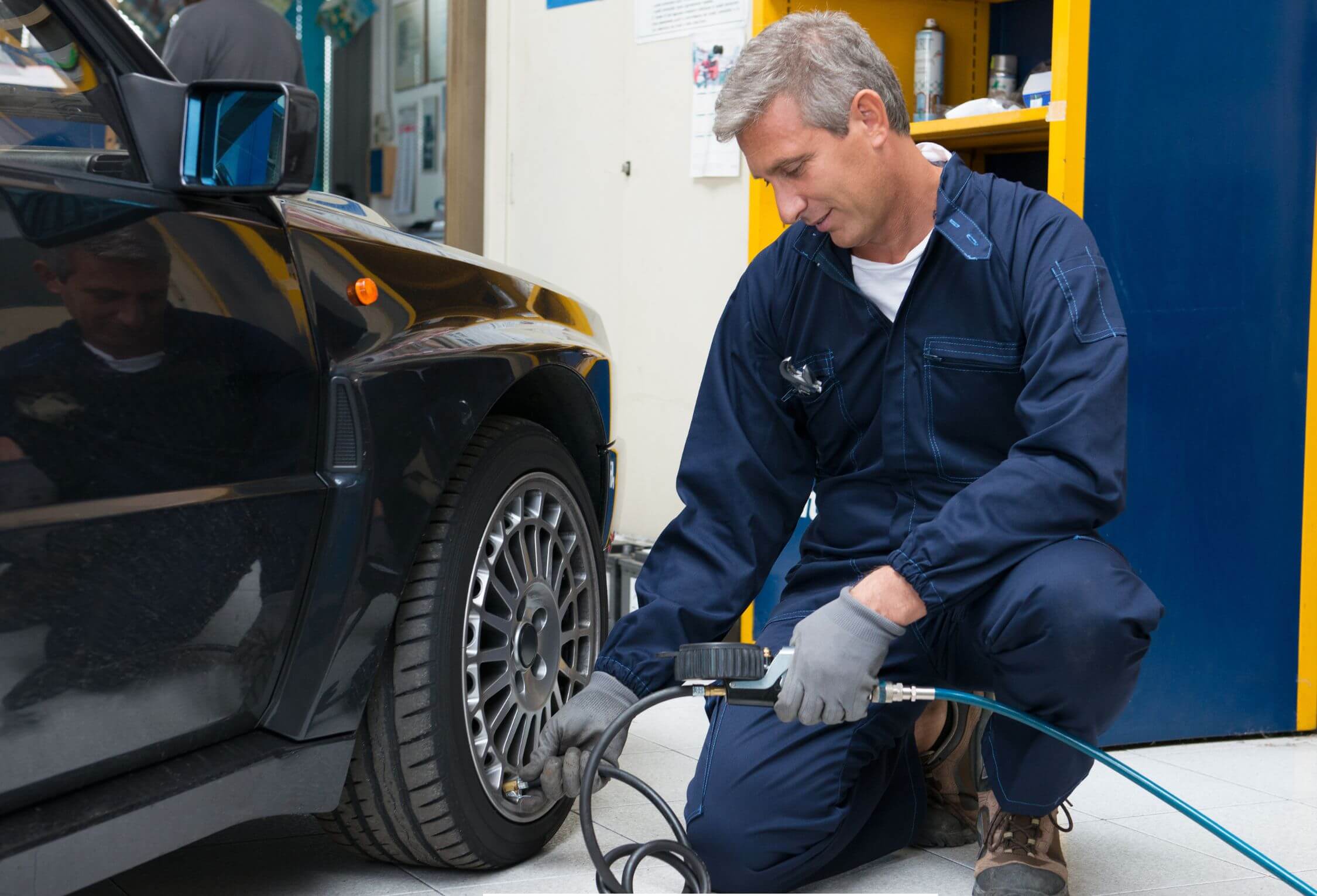Maintaining optimal tyre pressure is one of the simplest yet most effective ways to enhance fuel efficiency and ensure your vehicle’s safety. Despite its importance, many drivers often overlook tyre pressure until it becomes a visible issue. Under-inflated or over-inflated tyres can lead to increased fuel consumption, reduced tyre lifespan, and even dangerous driving conditions.
In this article, we’ll explore the connection between tyre pressure and fuel efficiency, the risks of improper tyre pressure, and tips to maintain the right pressure for optimal performance.
How Tyre Pressure Affects Fuel Efficiency
Tyres play a crucial role in how your vehicle interacts with the road. When tyre pressure is not at the recommended level, it directly impacts the car’s rolling resistance, which is the force required to keep the tyres moving.
Increased Rolling Resistance
Under-inflated tyres create a larger contact area with the road. This increases rolling resistance, forcing the engine to work harder and consume more fuel. Studies show that driving on tyres with low pressure can reduce fuel efficiency by up to 10%.
Over-Inflated Tyres and Energy Loss
Over-inflated tyres reduce the contact area with the road, leading to uneven wear and reduced traction. While this doesn’t increase rolling resistance, it compromises fuel efficiency by reducing the vehicle’s stability and performance.
The Risks of Improper Tyre Pressure
Ignoring tyre pressure can lead to a variety of issues, many of which affect not only fuel efficiency but also safety and vehicle longevity.
Reduced Tyre Lifespan
Both under-inflation and over-inflation can cause uneven tyre wear. Under-inflated tyres wear out faster on the edges, while over-inflated tyres experience excessive wear in the center. This shortens the overall lifespan of your tyres, leading to frequent replacements.
Compromised Handling and Safety
Tyres with improper pressure reduce your car’s ability to grip the road, especially in wet or slippery conditions. This affects handling, braking distance, and overall safety.
Increased Risk of Tyre Blowouts
Under-inflated tyres generate more heat due to increased friction, making them more susceptible to blowouts. This is particularly dangerous during high-speed driving or long road trips.
Benefits of Maintaining Proper Tyre Pressure
Ensuring that your tyres are inflated to the manufacturer’s recommended pressure offers several benefits beyond fuel efficiency.
Optimized Fuel Economy
Properly inflated tyres reduce rolling resistance, allowing the engine to operate efficiently. This translates into noticeable savings at the fuel pump.
Enhanced Driving Comfort
The right tyre pressure ensures a smoother ride by absorbing road impacts evenly. Over-inflated tyres can make the ride harsh, while under-inflated ones can feel sluggish.
Better Vehicle Performance
Maintaining the correct pressure improves steering response, braking performance, and overall handling, making your driving experience safer and more enjoyable.
Environmental Benefits
Improving fuel efficiency through proper tyre pressure reduces carbon emissions, contributing to a cleaner and more sustainable environment.
How to Check Tyre Pressure
Checking tyre pressure is a quick and easy process that can be done at home or at a nearby service station.
Tools You’ll Need
- A reliable tyre pressure gauge
- A portable air compressor (optional)
- Your vehicle’s owner manual or tyre placard for the recommended pressure
Steps to Check Tyre Pressure
Locate the Recommended Pressure: Find the recommended tyre pressure in your owner’s manual or on the tyre placard, usually located on the driver’s side door frame or fuel cap.
Measure When Tyres Are Cold: Tyres should be checked when they are cold, as driving heats them up and temporarily increases pressure.
Use the Tyre Pressure Gauge: Remove the valve cap and press the gauge firmly onto the valve stem to get a reading.
Compare the Reading: Check if the current pressure matches the recommended level. Adjust if necessary by adding or releasing air.
Repeat for All Tyres: Don’t forget to check the spare tyre as well, as it can also lose pressure over time.
How Often Should You Check Tyre Pressure?
Tyre pressure should ideally be checked at least once a month or before long road trips. Regular checks are essential as tyres naturally lose air over time, even without visible punctures.
Factors Affecting Tyre Pressure
Temperature Changes: Tyre pressure drops in cold weather and increases in hot weather. A 10-degree Fahrenheit change in temperature can alter pressure by about 1 PSI.
Driving Habits: Frequent long-distance or high-speed driving can cause tyres to lose air faster.
Load Weight: Carrying heavy loads increases pressure on tyres, requiring adjustments to maintain optimal levels.
The Impact of Tyre Pressure Monitoring Systems
Modern vehicles often come equipped with Tyre Pressure Monitoring Systems (TPMS) that alert drivers when pressure is too low. While TPMS is a helpful feature, it’s not a substitute for regular manual checks, as it may not detect minor variations that still impact fuel efficiency.
Common Myths About Tyre Pressure
- There are several misconceptions about tyre pressure that can lead to improper maintenance.
- Myth: Over-Inflating Tyres Improves Fuel Efficiency
- While over-inflated tyres reduce rolling resistance, they compromise safety, handling, and tyre lifespan. The slight fuel savings are not worth the trade-offs.
- Myth: Tyre Pressure Only Matters in Extreme Weather
- Tyre pressure is important year-round, as it affects fuel efficiency and performance regardless of weather conditions.
- Myth: New Tyres Don’t Need Pressure Checks
- Even brand-new tyres can lose air over time, making regular checks essential for maintaining optimal performance.
Tips for Maintaining Proper Tyre Pressure
- Invest in Quality Tools
- A high-quality tyre pressure gauge and portable air compressor make it easier to maintain tyre pressure at home.
- Schedule Regular Inspections
- Include tyre pressure checks in your routine vehicle maintenance schedule. Many service stations offer free checks as part of their services.
- Be Mindful of Seasonal Changes
- Adjust tyre pressure according to seasonal temperature changes to avoid over-inflation in summer or under-inflation in winter.
- Avoid Overloading Your Vehicle
- Carrying excessive weight can increase tyre pressure beyond safe levels. Refer to your vehicle’s load capacity to avoid overloading.
Why Tyre Pressure Matters for Long-Term Savings
Proper tyre pressure isn’t just about saving fuel in the short term; it’s also about reducing long-term expenses. By minimizing tyre wear and improving fuel efficiency, you’ll save money on tyre replacements and fuel costs over time. Additionally, maintaining the right pressure ensures your car remains safe and reliable, reducing the likelihood of costly repairs due to accidents or damage.
Regularly checking and maintaining your tyre pressure is a small effort with significant rewards. Not only will you save money at the pump, but you’ll also enjoy a safer and more comfortable driving experience. Prioritize tyre pressure as part of your routine maintenance to maximize your vehicle’s performance and fuel efficiency.



